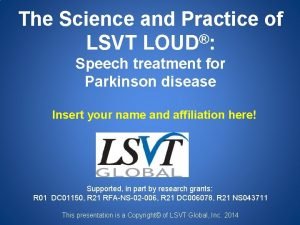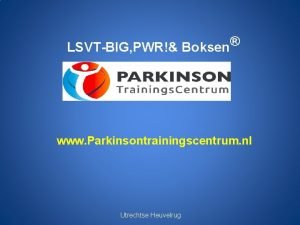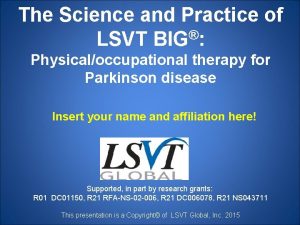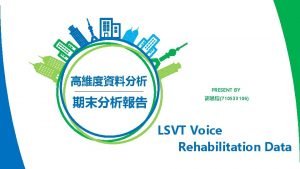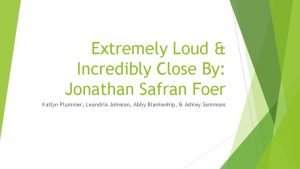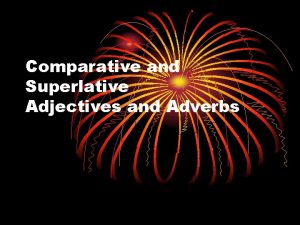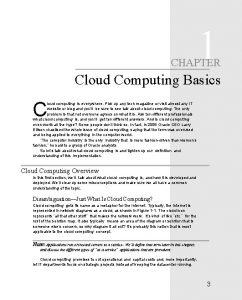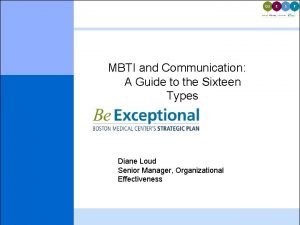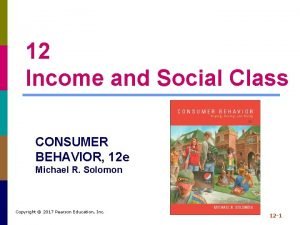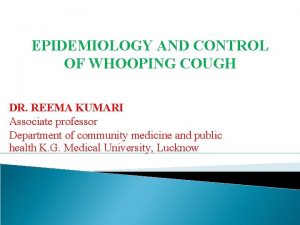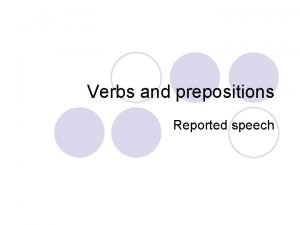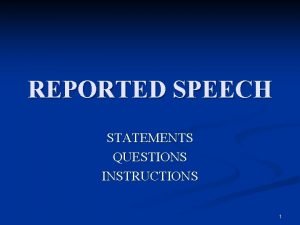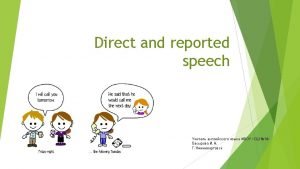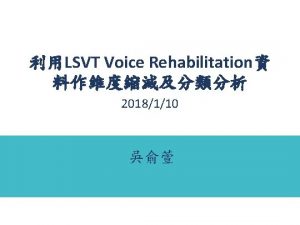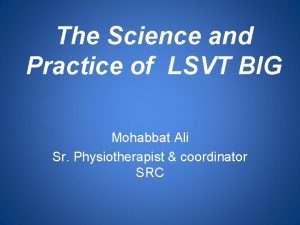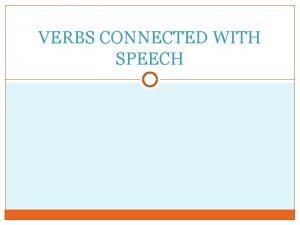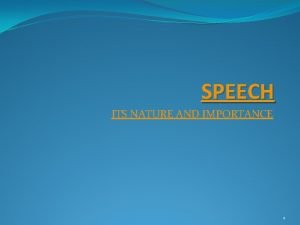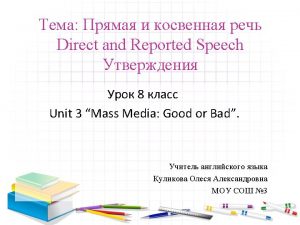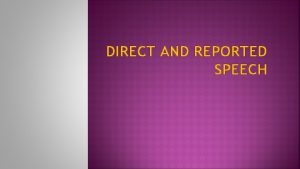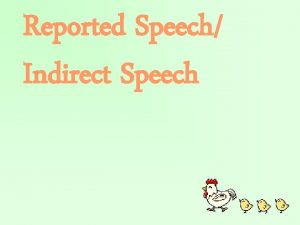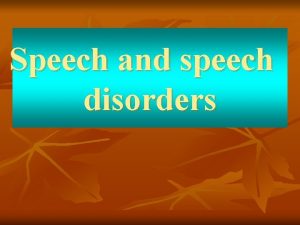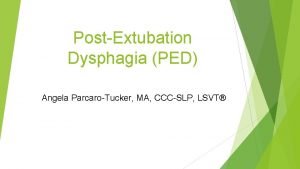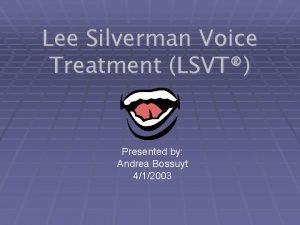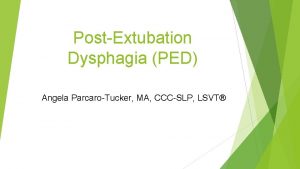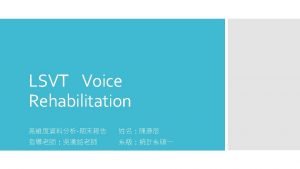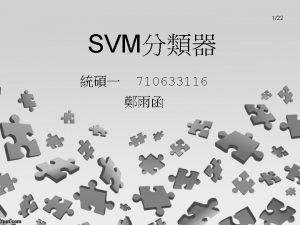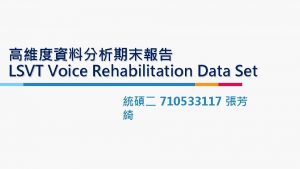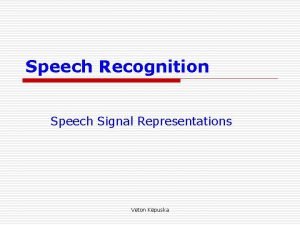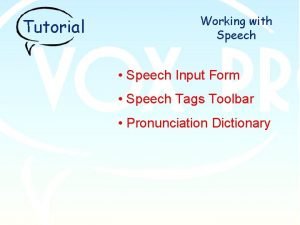The Science and Practice of LSVT LOUD Speech





























































- Slides: 61

The Science and Practice of LSVT LOUD®: Speech treatment for Parkinson disease Insert your name and affiliation here! Supported, in part by research grants: R 01 DC 01150, R 21 RFA-NS-02 -006, R 21 DC 006078, R 21 NS 043711 This presentation is a Copyright© of LSVT Global, Inc. 2014

Objectives of Presentation Explain advances in neuroscience and impact on the field of rehabilitation Discuss development and data on an efficacious speech treatment LSVT LOUD Briefly describe development and key aspects of limb motor treatment LSVT BIG Outline future directions and alternative modes of treatment delivery using technology

It is a “Stunning Time” to be in rehabilitation today q Basic science evidence for the value of exercise in PD (classically drugs, surgery, today…) q Identified key principles of exercise that drive activity-dependent neural plasticity q Demonstrated that exercise can improve brain functioning (neural plasticity) and may slow disease progression q Exercise is Medicine! Kliem & Jones, 2008; Ludlow et al, 2008

Legitimate Therapeutic Options To provide symptomatic relief; improve function Pharmacological (L-dopa) Neurosurgical (DBS-STN) Voice and Body Exercise Zigmond et al, 2009

Video Example: 59 year old female 2. 5 years post-diagnosis On-meds pre and post video Pre/post LSVT LOUD (Lee Silverman Voice Treatment) Intensive physical exercise of speech mechanism

Insert Video “Short Shirley”

1. Background and development Critical need for speech treatment in PD

“If only we could hear and understand her” Family of Mrs. Lee Silverman 1987

BACKGROUND ON LSVT 1987 “Lee Silverman Center for Parkinson’s” Scottsdale, Arizona Carolyn Mead Bonitati M. A. , CCC-SP

6 Million people with PD worldwide 89% have a speech or voice problem (Logemann et al. , 1978) 4% receive traditional speech therapy (Hartelius & Swenson, 1994; Oxtoby, 1982)

Consensus 1990: Speech treatment (articulation and rate at low dosage) does not work (Sarno, 1968; Allan, 1970; Green, 1980; Aronson, 1990; Weiner & Singer, 1989)

Surgical and Pharmacological Treatment doesn’t improve speech in PD • Pharmacological: L-Dopa, dopamine agonists • Surgical: Fetal Cell Transplant, Deep Brain Stimulation (DBS) Informal survey 25 -60% speech worse after DBS (PA) • Medical interventions effective on limbs, unestablished effects on speech (Leanderson, Meyerson, Persson, 1971; Solomon & Hixon, 1993; Larson, Ramig & Scherer, 1994; Larson, Ramig & Johnson, 1994; Freed et al. , 1992; Goberman, 2005; Trail et al. , 2005; Pinto et al. , 2004; Sapir et al. , in press; Krack et al. , 2003; Wang et al. , 2003; Rousseaux et al. , 2000)

Creating a treatment that works A journey from discovery through efficacy LSVT LOUD: The fundamentals of therapy LSVT LOUD Outcomes: Efficacy data

Speech Characteristics in PD Reduced loudness Hoarse voice quality Monotone Imprecise articulation Vocal tremor (Darley et al, 1969 a; 1969 b; 1975; Logemann et al, 1978) Some patients report volume, hoarse voice or monotone as the first PD symptom (Aronson, 1990) (perceived as bored, disinterested, apathetic)

Mean vocal SPL for subjects with PD and HC PD are 2 -4 d. B less than HC across tasks (Fox and Ramig , 1997) 80 PD (N = 30) 78 HC (N = 14) d. B SPL at 30 cm 76 74 72 70 68 66 64 Sustained Phonation Rainbow Passage Monologue TASK Picture Description

PD less likely to participate in conversations or have confidence in voice PD=30, HC=14 (Fox and Ramig, 1997) Self-perceptual Ratings of Communication 100 90 Percentage Score (0 -100%) 80 70 60 PD 50 HC 40 30 20 10 0 Understood by Others Particpate in Conversation Start Conversations

Does this speech problem matter? “if I have no voice, I have no life” -Natalie “No one listens to me anymore” -Shirley “… people with PD live for years frustrated by communication impairment, withdrawal, social isolation and embarrassment “ (Miller et al. , 2006)

20+ year journey from invention to scale-up Phase IV, V Phase III Phase I, II Over 8 million dollars in NIH funding 1987 -89: Initial invention; Pilot data (Scottsdale) 1989 -91: Office of Education OE-NIDRR 1991 -94: OE-NIDRR 1990 -95: NIH funded RCT Efficacy 1995 -00: NIH funded EMG, Kinematics 2002 -07: NIH funded RCT Spread of effects 2007 -12: NIH funded RCT, imaging 2001 -02: Coleman Institute (PDA; LSVTC) 2002 -04: NIH and Michael J FOX Foundation (R 21) 2002 -04: Coleman Institute (VT; LSVTVT) 2004 -06: NIH LSVTVT (R 21) 2004 : Coleman Institute (LSVT Down Syndrome) 2004 -07: LSVT–Dissemination 2006: Technology-enhanced Clinician Training (SBIR)

LSVT LOUD

TARGET Loud is more than a laryngeal event – spread of effects LOUD SOFT HEALTHY LOUDNESS

MODE Intensive High effort Intensive dosage and within sessions High effort Repetitions Force/resistance Accuracy Fatigue What do data say? Intensive practice is important for maximal plasticity (Kliem & Jones, 2008)

CALIBRATION r MISMATCH between on-line perception of output and how others perceive it “I’m not too soft” “I can’t speak like this, I am shouting!!” Fox et al, 2002; Sapir et al, 2011

Mode Intensive, High effort Target Calibration Self-perception, Internal cue, Increase Loudness increase amplitude of output

LSVT LOUD Outcomes Efficacy data

Advances in Clinical Efficacy (Ramig et al, 1995; 1996; 2001 a; 2001 b; Goetz, 2003) Cross-system effects, Neural changes P. Fox, Liotti (2003) Narayana (2010) (PET) Spielman, Borod (2003) (facial expression) Dromey, (1995) (articulation) El-Sharkawi, Logemann (2002) (swallowing) Sapir (2007; 2010) (articulatory acoustics) Smith, M. (1995) (adduction) (2001) (STI) Smith, A. Ramig & Dromey (1996) (aerodynamics) Taskoff (2001) (perceptual) Huber, Stathopoulos, (2003) (respiratory kinematics) Baker (1998), Luschei (1999) (EMG)

Video Example: Pre/Post LSVT LOUD Vocal Folds

Insert Video “Extra short vocal folds”

Long-term follow-up? CONVENTIONAL WISDOM “Changes in treatment room disappear on the way to the parking lot” (Allan, 1970; Sarno, 1968)

Ramig et al. , 2001; J Neurol, Neurosurgery, Psychiatry Level 1 Evidence Goetz, 2003 N=45 SPL Rainbow (50 cm) 75 LSVT® LOUD 70 65 RESP 60 -2 0 2 4 6 8 10 12 14 16 18 20 22 24 Months LSVT Blinded, no med change Same time med R

2. Unexpected outcomes: System-wide spread & Insight into Basic mechanism Articulation Rate Speech Motor Stability Swallow Face PET (Spielman, et al. 2002; El-Sharkawi, 2002; Spielman et al. , 2003; Kleinow et al. , 2001; Liotti et al. , 2003)

SWALLOWING PRE POST LSVT® LOUD Approximate oral residue percentage (ORES) *=p<0. 05 El-Sharkawi et al (2002) 25 20 Before LSVT 15 After LSVT 10 * * 5 0 1 ml 3 ml 5 ml 10 ml cup paste cookie

Phonation Task - PD N=5 Liotti et al, 2003; Neurology Pre-LSVT SMA R Put +60 DLPF 9 +4+34 +4 +34 R a Ins +10 Post-LSVT L +60 R +34 +4 +34 +10 z-score -4 ± 2. 25 +4

To a patient……major life impact “My voice is alive again” “I can talk to my grandchildren!” “I feel like my old self” “I am confident I can communicate!”

What are the LSVT LOUD exercises? Daily tasks First half of treatment session Rescale amplitude of motor output through CORE Loud q Sustained “ah” (minimum 15 reps) High/Low “ah” (minimum 15 reps) q Functional phrases (minimum 50 reps) q Hierarchical speech tasks Second half of session Train amplitude from CORE exercises into in context specific and variable speaking activities Week 1 – words, phrases q Week 2 – sentences q Week 3 – reading q Week 4 - conversation q Shorter, simple Longer, more complex

Video Example: Homework Helper “Ah” Clip

Insert Video Homework Helper “ah”

Insert Video Homework Helper “high-low”

Insert Video Homework Helper “phrases”

Speech Hierarchy Week 1 – words/phrases short/simple conversation – bridge gap to conversation Week 2 – sentences/reading short/simple conversation Week 3 – reading/conversation Week 4 – conversation

Insert Video Homework Helper “hierarchy”


If you don’t feel like you are talking “too loud” you are not talking loud enough!!

CALIBRATION Learning ry o s sen learn n i a Retr ion and e for rat nal cu b i l nd a r ca e t t r in ffo new vocal e s es L n N d W lou

3. Fundamentals of treatment generalize to: Other systems (limb motor)

LSVT ® LOUD ® LSVT BIG (Ebersbach et al, 2010; Farley & Koshland, 2005; Fox, et al. , 2012)

TARGET BIG (Large amplitude whole body movement) Single Target - Triggers Activation across motor systems SMALL BIG

MODE Delivery – Certified LSVT BIG Physical/Occupational Therapist • 1: 1 intervention Time of Practice – 4 consecutive days per week for 4 weeks – 16 sessions in one month – 60 minute sessions – Daily carryover assignments (30 days/entire month) – Daily homework (30 days/entire month)

CALIBRATION MISMATCH between on-line perception of output and how others perceive it “I had no idea how small my world had become” “I can’t move like this, people will think I am crazy!!”

Patient case: Bernie • 71 year-old, diagnosed with Parkinson’s disease in 1994 • Reason for referral: slowness and difficulty walking, history of falls, freezing • Optimized on PD medications • Hoehn & Yahr 3

• Insert LSVT Walk BIG

Case Study Outcomes: PRE Falls Assistive device Gait Velocity % of age matched norm Endurance ü ü 1 -2/month Cane 0. 35 m/s 29. 6 % 730 ft POST 0/month None 1. 17 m/s 100% 1200 ft To improve his walking To go to the movies To play with his grandchildren To go out to dinner with friends and family

Comparing Exercise in Parkinson’s Disease — The Berlin BIG Study (2010, Movement Disorders) Georg Ebersbach, * Almut Ebersbach, Daniela Edler, Olaf Kaufhold, Matthias Kusch, Andreas Kupsch, and Jo¨rg Wissel 1 1 1 2 3 FIG. 2. UPDRS motor score (blinded rating), mean change from baseline (vertical bars 5 standard deviations). Change between baseline and follow up at week 16 was superior in BIG (interrupted line) compared to WALK (dotted line) and HOME (solid line), P <0. 001. ANCOVA did not disclose significant differences between in intermediate and final assessments.

Future Directions LSVT Programs and Technology (telepractice and software programs)

LSVT e. LOUD LSVT Companion Telepractice Funded by: NIH-NIDCD & Michael J. Fox Foundation www. LSVTGlobal. com

Pre, Post, 6 month d. B SPL (p< 0. 001) Changes consistent with those reported in previously published data (Halpern et al. , 2012)

Video LSVT Companion Home Edition Insert video: Companion Home Demo

Summary Advances in neuroscience have provided evidence supporting the positive impact of exercise-based protocols in people with PD LSVT Programs have been developed and studied over the past 20 years LSVT LOUD has well established efficacy and is considered Level 1 evidence for speech treatment in PD LSVT BIG is one type of physical therapy program that has potential to offer improvements in movement and quality of life for people with PD Technology will assist with accessibility

How to locate LSVT LOUD Clinicians? Insert Video on Clinician directory

How to get started with LSVT LOUD and LSVT BIG • Ask your doctor for a referral and a prescription for a speech or physical/occupational therapy evaluation and treatment • Visit www. lsvtglobal. com to find an LSVT LOUD or LSVT BIG Certified Clinician in your area (as per video demonstration) • DVDs available to introduce you to voice exercises used in LSVT LOUD and movement exercises used in LSVT BIG: www. lsvtglobal. com/products or www. amazon. com/shops/LSVTGlobal

“If my possessions were taken from me with one exception, I would choose to keep the power of communication, for by it I would soon regain all the rest” Daniel Webster

QUESTIONS? info@lsvtglobal. com www. lsvtglobal. com
 Printable lsvt loud exercises handout
Printable lsvt loud exercises handout Pwr oefeningen
Pwr oefeningen Lsvt big maximal daily exercises
Lsvt big maximal daily exercises Present by
Present by Economics … my favorite subject at school
Economics … my favorite subject at school What is mowaw
What is mowaw Superlative of slowly
Superlative of slowly Sound travels fastest through
Sound travels fastest through Listen and match pretty shy good
Listen and match pretty shy good Round flotation device candy
Round flotation device candy Shy степени сравнения
Shy степени сравнения Carol went shopping yesterday
Carol went shopping yesterday That is a very loud boat something must be wrong with it
That is a very loud boat something must be wrong with it Alfabeto hispano
Alfabeto hispano Loud to php
Loud to php Loud computing
Loud computing Mbti
Mbti Eprosn
Eprosn Noisy adverb
Noisy adverb Ring christmas bells ring them loud
Ring christmas bells ring them loud Quiet vs loud brand signals
Quiet vs loud brand signals Read out loud
Read out loud Loud crowing inspiration
Loud crowing inspiration We do really loud
We do really loud Myeplg
Myeplg Match the verbs and prepositions with the definitions
Match the verbs and prepositions with the definitions Pure speech and symbolic speech
Pure speech and symbolic speech Ann says i'm tired
Ann says i'm tired Direct simple past
Direct simple past Jim said to me please lend me your pen
Jim said to me please lend me your pen Look at the direct speech and complete the reported speech
Look at the direct speech and complete the reported speech Joe said please come to my party
Joe said please come to my party Hát kết hợp bộ gõ cơ thể
Hát kết hợp bộ gõ cơ thể Frameset trong html5
Frameset trong html5 Bổ thể
Bổ thể Tỉ lệ cơ thể trẻ em
Tỉ lệ cơ thể trẻ em Voi kéo gỗ như thế nào
Voi kéo gỗ như thế nào Tư thế worms-breton
Tư thế worms-breton Chúa sống lại
Chúa sống lại Các môn thể thao bắt đầu bằng từ đua
Các môn thể thao bắt đầu bằng từ đua Thế nào là hệ số cao nhất
Thế nào là hệ số cao nhất Các châu lục và đại dương trên thế giới
Các châu lục và đại dương trên thế giới Công của trọng lực
Công của trọng lực Trời xanh đây là của chúng ta thể thơ
Trời xanh đây là của chúng ta thể thơ Mật thư tọa độ 5x5
Mật thư tọa độ 5x5 101012 bằng
101012 bằng Phản ứng thế ankan
Phản ứng thế ankan Các châu lục và đại dương trên thế giới
Các châu lục và đại dương trên thế giới Thơ thất ngôn tứ tuyệt đường luật
Thơ thất ngôn tứ tuyệt đường luật Quá trình desamine hóa có thể tạo ra
Quá trình desamine hóa có thể tạo ra Một số thể thơ truyền thống
Một số thể thơ truyền thống Cái miệng xinh xinh thế chỉ nói điều hay thôi
Cái miệng xinh xinh thế chỉ nói điều hay thôi Vẽ hình chiếu vuông góc của vật thể sau
Vẽ hình chiếu vuông góc của vật thể sau Thế nào là sự mỏi cơ
Thế nào là sự mỏi cơ đặc điểm cơ thể của người tối cổ
đặc điểm cơ thể của người tối cổ Thế nào là giọng cùng tên?
Thế nào là giọng cùng tên? Vẽ hình chiếu đứng bằng cạnh của vật thể
Vẽ hình chiếu đứng bằng cạnh của vật thể Phối cảnh
Phối cảnh Thẻ vin
Thẻ vin đại từ thay thế
đại từ thay thế điện thế nghỉ
điện thế nghỉ Tư thế ngồi viết
Tư thế ngồi viết
